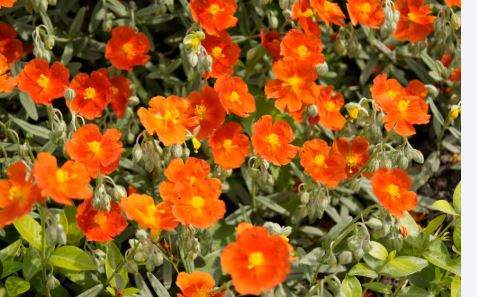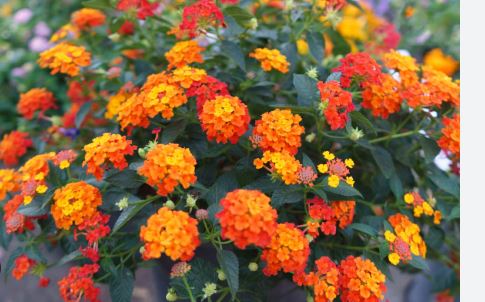
Perennial ground covers with orange flowers are low-growing plants that spread to form dense, vibrant carpets, infusing gardens with warm, eye-catching color. Their bright orange blooms, ranging from soft peach to fiery tangerine, create bold focal points, typically flowering in spring or summer. These perennials return year after year, making them ideal for low-maintenance landscapes where they suppress weeds, stabilize soil, or add vivid contrast to green foliage.
These ground covers thrive in various conditions, often favoring full sun but some tolerating partial shade, and they adapt to a range of soil types, provided drainage is adequate. Many are drought-tolerant, perfect for dry or rocky areas, while others prefer moist environments, fitting well in borders or near water features. Their versatility makes them suitable for diverse settings, including rock gardens, slopes, or as edging along pathways.
The orange flowers of these perennials frequently attract pollinators like bees, butterflies, and hummingbirds, boosting garden biodiversity. Blooms may appear as clusters, single flowers, or sprays, offering texture against green or variegated foliage. Some varieties feature evergreen or semi-evergreen leaves, ensuring year-round interest, which enhances their value for both ornamental and functional landscaping.
Care is typically minimal once established. Regular watering during the first season promotes strong root systems, but many become self-sufficient afterward, thriving in challenging conditions. Pruning or trimming after flowering maintains a tidy appearance and encourages denser growth. Some varieties may spread vigorously, so monitoring their growth prevents them from crowding out neighboring plants.
Incorporating these ground covers into landscapes adds a cheerful, dynamic energy. They can soften hardscapes like walkways, spill over walls, or fill gaps in mixed beds, creating cohesion in garden designs. By selecting varieties suited to local climate and soil conditions, gardeners can achieve a lush, orange-flowered carpet that transforms outdoor spaces with minimal effort year after year.

Ground Covers With Orange Flowers
Creeping Zinnia (Zinnia angustifolia ‘Orange Profusion’)
- Description: Low-growing (6-8 inches) with bright orange, daisy-like flowers from summer to fall.
- Conditions: Full sun, well-drained soil. Drought-tolerant.
- Uses: Borders, containers, mass plantings.
Orange Ice Plant (Delosperma cooperi ‘Fire Spinner’)
- Description: Succulent ground cover (2-4 inches) with vibrant orange flowers in summer and fleshy leaves.
- Conditions: Full sun, sandy, well-drained soil. Highly drought-tolerant.
- Uses: Rock gardens, dry slopes, xeriscaping.
Creeping Avens (Geum coccineum ‘Koi’)
- Description: Clumping (6-8 inches) with bright orange flowers in late spring to summer and lobed foliage.
- Conditions: Full sun to partial shade, well-drained soil.
- Uses: Rock gardens, borders, edging.
Orange Creeping Phlox (Phlox subulata ‘Orange Perfection’)
- Description: Mat-forming (4-6 inches) with peach-orange flowers in spring and evergreen foliage.
- Conditions: Full sun, well-drained soil. Tolerates poor soil.
- Uses: Rock gardens, slopes, spilling over walls.
Orange Yarrow (Achillea millefolium ‘Terracotta’)
- Description: Spreading (6-12 inches) with clusters of terracotta-orange flowers in summer.
- Conditions: Full sun, well-drained soil. Drought-tolerant.
- Uses: Borders, pollinator gardens, rock gardens.
Orange Creeping Sedum (Sedum kamtschaticum ‘Orange’)
- Description: Succulent (4-6 inches) with star-shaped orange flowers in summer and fleshy leaves.
- Conditions: Full sun, well-drained, poor soil. Highly drought-tolerant.
- Uses: Rock gardens, dry areas, containers.
Orange Rock Rose (Helianthemum nummularium ‘Henfield Brilliant’)
- Description: Low-growing (6-8 inches) with vivid orange flowers in summer and evergreen foliage.
- Conditions: Full sun, well-drained, sandy soil. Drought-tolerant.
- Uses: Rock gardens, slopes, xeriscaping.
Orange Potentilla (Potentilla nepalensis ‘Flamenco’)
- Description: Spreading (6-12 inches) with orange-red flowers in summer and strawberry-like foliage.
- Conditions: Full sun to partial shade, well-drained soil.
- Uses: Borders, cottage gardens, ground cover for small areas.
Orange Coral Bells (Heuchera ‘Marmalade’)
- Description: Clumping (6-8 inches) with peach-orange foliage and small, reddish-orange flowers in spring.
- Conditions: Partial shade to full sun, well-drained soil.
- Uses: Shady borders, containers, under trees.
Orange Creeping Veronica (Veronica prostrata ‘Aztec Gold’)
- Description: Mat-forming (4-6 inches) with orange-tinted flowers in late spring and golden foliage.
- Conditions: Full sun, well-drained soil. Drought-tolerant.
- Uses: Rock gardens, edging, slopes.
Orange Sundrops (Oenothera tetragona ‘Sunset Boulevard’)
- Description: Spreading (6-12 inches) with bright orange-yellow flowers in summer.
- Conditions: Full sun, well-drained soil. Drought-tolerant.
- Uses: Borders, meadow gardens, pollinator-friendly areas.
Orange Creeping Wallflower (Erysimum ‘Apricot Twist’)
- Description: Low-growing (6-8 inches) with apricot-orange flowers in spring to early summer.
- Conditions: Full sun, well-drained soil. Moderately drought-tolerant.
- Uses: Rock gardens, borders, cascading over walls.
Orange Creeping Zauschneria (Zauschneria garrettii ‘Orange Carpet’)
- Description: Spreading (4-6 inches) with tubular, bright orange flowers in late summer to fall, attractive to hummingbirds.
- Conditions: Full sun, well-drained, sandy soil. Highly drought-tolerant.
- Uses: Rock gardens, slopes, pollinator gardens.
Orange Creeping Sedum (Sedum rupestre ‘Angelina’)
- Description: Succulent (3-6 inches) with golden-orange foliage and small orange-yellow flowers in summer.
- Conditions: Full sun, well-drained, poor soil. Highly drought-tolerant.
- Uses: Rock gardens, containers, dry areas.
Orange Geum (Geum chiloense ‘Blazing Sunset’)
- Description: Clumping (6-12 inches) with double, fiery orange flowers in early summer and lobed foliage.
- Conditions: Full sun to partial shade, well-drained soil.
- Uses: Borders, rock gardens, cottage gardens.
Orange Creeping Butterfly Weed (Asclepias tuberosa ‘Hello Yellow’)
- Description: Spreading (6-12 inches) with clusters of orange-yellow flowers in summer, attracting pollinators.
- Conditions: Full sun, well-drained soil. Drought-tolerant.
- Uses: Pollinator gardens, meadow gardens, borders.
Orange Creeping Coreopsis (Coreopsis verticillata ‘Zagreb’)
- Description: Low-growing (6-8 inches) with bright orange-yellow, daisy-like flowers in summer.
- Conditions: Full sun, well-drained soil. Drought-tolerant.
- Uses: Borders, rock gardens, mass plantings.
Orange Creeping Daylily (Hemerocallis ‘Stella de Oro’)
- Description: Clumping (6-12 inches) with trumpet-shaped, orange-yellow flowers from summer to fall.
- Conditions: Full sun to partial shade, well-drained soil.
- Uses: Borders, slopes, ground cover for small areas.
Orange Creeping Lantana (Lantana montevidensis ‘Luscious Citrus Blend’)
- Description: Trailing (6-12 inches) with clusters of orange flowers in warm seasons, evergreen in mild climates.
- Conditions: Full sun, well-drained soil. Drought-tolerant, frost-sensitive.
- Uses: Hanging baskets, slopes, warm-climate gardens.
Orange Creeping Cinquefoil (Potentilla verna ‘Nana’)
- Description: Compact (3-6 inches) with small, orange-yellow flowers in spring to summer and fine foliage.
- Conditions: Full sun, well-drained soil. Drought-tolerant.
- Uses: Rock gardens, edging, alpine gardens.
General Care Tips
- Watering: Water regularly during establishment; many are drought-tolerant once settled, but some prefer consistent moisture.
- Pruning: Trim after flowering to maintain shape and encourage dense growth.
- Invasiveness: Monitor aggressive spreaders to prevent overtaking other plants.
- Soil: Most prefer well-drained soil; some tolerate poor or dry conditions.
- Sunlight: Most thrive in full sun, but several adapt to partial shade.
- Check USDA hardiness zones (most are hardy in zones 4-9, some to zone 5 or 6).
- Many attract pollinators like bees and butterflies, enhancing garden biodiversity.
- Pair with purple, white, or yellow ground covers for striking contrast in garden designs.